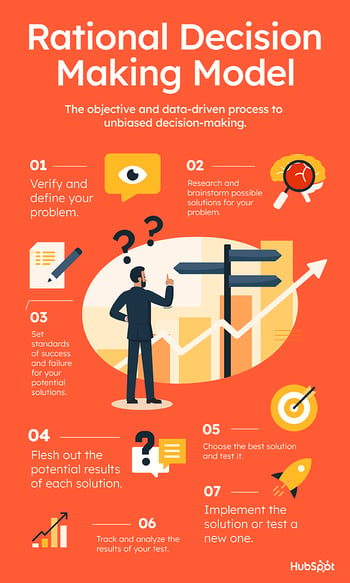Psychology tells us that emotions drive our behavior, while logic only justifies our actions after the fact. Marketing confirms this theory. Humans associate the same personality traits with brands as they do with people — choosing your favorite brand is like choosing your best friend or significant other. We go with the option that makes us feel something.
But emotions can cloud your reasoning, especially when you need to do something that could cause internal pain, like giving constructive criticism, or moving on from something you’re attached to, like scrapping a favorite topic from your team’s content calendar.
There’s a way to suppress this emotional bias, though. It’s a thought process that’s completely objective and data-driven. It’s called the rational decision making model, and it will help you make logically sound decisions even in situations with major ramifications, like pivoting your entire blogging strategy.
But before we learn each step of this powerful process, let’s go over what exactly rational decision making is and why it’s important.
Rational decision making is an important skill to possess, especially in the digital marketing industry. Humans are inherently emotional, so our biases and beliefs can blur our perception of reality. Fortunately, data sharpens our view. By showing us how our audience actually interacts with our brand, data liberates us from relying on our assumptions to determine what our audience likes about us.
Rational Decision Making Model: 7 Easy Steps(+ Examples)

1. Verify and define your problem.
To prove that you actually have a problem, you need evidence for it. Most marketers think data is the silver bullet that can diagnose any issue in our strategy, but you actually need to extract insights from your data to prove anything. If you don’t, you’re just looking at a bunch of numbers packed into a spreadsheet.
To pinpoint your specific problem, collect as much data from your area of need and analyze it to find any alarming patterns or trends.
Example:
“After analyzing our blog traffic report, we now know why our traffic has plateaued for the past year — our organic traffic increases slightly month over month but our email and social traffic decrease.”
2. Research and brainstorm possible solutions for your problem.
Expanding your pool of potential solutions boosts your chances of solving your problem. To find as many potential solutions as possible, you should gather plenty of information about your problem from your own knowledge and the internet. You can also brainstorm with others to uncover more possible solutions.
Example:
Potential Solution 1: “We could focus on growing organic, email, and social traffic all at the same time.”
Potential Solution 2: “We could focus on growing email and social traffic at the same time — organic traffic already increases month over month while traffic from email and social decrease.”
Potential Solution 3: “We could solely focus on growing social traffic — growing social traffic is easier than growing email and organic traffic at the same time. We also have 2 million followers on Facebook, so we could push our posts to a ton of readers.”
Potential Solution 4: “We could solely focus on growing email traffic — growing email traffic is easier than growing social and organic traffic at the same time. We also have 250,000 blog subscribers, so we could push our posts to a ton of readers.”
Potential Solution 5: “We could solely focus on growing organic traffic — growing organic traffic is easier than growing social and email traffic at the same time. We also just implemented a pillar-cluster model to boost our domain’s authority, so we could attract a ton of readers from Google.”
3. Set standards of success and failure for your potential solutions.
Setting a threshold to measure your solutions’ success and failure lets you determine which ones can actually solve your problem. Your standard of success shouldn’t be too high, though. You’d never be able to find a solution. But if your standards are realistic, quantifiable, and focused, you’ll be able to find one.
Example:
“If one of our solutions increases our total traffic by 10%, we should consider it a practical way to overcome our traffic plateau.”
4. Flesh out the potential results of each solution.
Next, you should determine each of your solutions’ consequences. To do so, create a strength and weaknesses table for each alternative and compare them to each other. You should also prioritize your solutions in a list from best chance to solve the problem to worst chance.
Example:
Potential Result 1: ‘Growing organic, email, and social traffic at the same time could pay a lot of dividends, but our team doesn’t have enough time or resources to optimize all three channels.”
Potential Result 2: “Growing email and social traffic at the same time would marginally increase overall traffic — both channels only account for 20% of our total traffic.”
Potential Result 3: “Growing social traffic by posting a blog post everyday on Facebook is challenging because the platform doesn’t elevate links in the news feed and the channel only accounts for 5% of our blog traffic. Focusing solely on social would produce minimal results.”
Potential Result 4: “Growing email traffic by sending two emails per day to our blog subscribers is challenging because we already send one email to subscribers everyday and the channel only accounts for 15% of our blog traffic. Focusing on email would produce minimal results.”
Potential Result 5: “Growing organic traffic by targeting high search volume keywords for all of our new posts is the easiest way to grow our blog’s overall traffic. We have a high domain authority, Google refers 80% of our total traffic, and we just implemented a pillar-cluster model. Focusing on organic would produce the most results.”
5. Choose the best solution and test it.
Based on the evaluation of your potential solutions, choose the best one and test it. You can start monitoring your preliminary results during this stage too.
Example:
“Focusing on organic traffic seems to be the most effective and realistic play for us. Let’s test an organic-only strategy where we only create new content that has current or potential search volume and fits into our pillar cluster model.”
6. Track and analyze the results of your test.
Track and analyze your results to see if your solution actually solved your problem.
Example:
“After a month of testing, our blog traffic has increased by 14% and our organic traffic has increased by 21%.”
7. Implement the solution or test a new one.
If your potential solution passed your test and solved your problem, then it’s the most rational decision you can make. You should implement it to completely solve your current problem or any other related problems in the future. If the solution didn’t solve your problem, then test another potential solution that you came up with.
Example:
“The results from solely focusing on organic surpassed our threshold of success. From now on, we’re pivoting to an organic-only strategy, where we’ll only create new blog content that has current or future search volume and fits into our pillar cluster model.”
Avoid Bias With A Rational Decision Making Process
As humans, it’s natural for our emotions to take over your decision making process. And that’s okay. Sometimes, emotional decisions are better than logical ones. But when you really need to prioritize logic over emotion, arming your mind with the rational decision making model can help you suppress your emotion bias and be as objective as possible.
Editor’s note: This post was originally published in July 2018 and has been updated for comprehensiveness.



